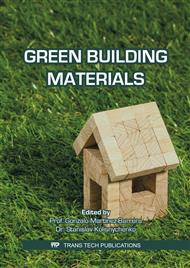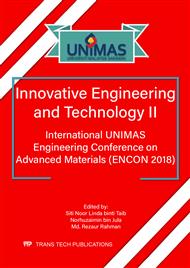[1]
J. W. P. Campbell, W. Pryce. Brick: A World History. Thames & Hudson, London. Chap. 1, (2003).
Google Scholar
[2]
J. Anderson, D. Shiers. The Green Guide to Specification. Oxford: Blackwell Science, (2002).
Google Scholar
[3]
BS 5628-1-1992 - Code of practice for use of masonry - Structural use of unreinforced masonry.
DOI: 10.3403/00078576
Google Scholar
[4]
A. A. Mohammed. Assessment the Mechanical Properties of Soil Cement Interlocking (SCI) Bricks: A Case Study in Malaysia. International Journal of Advances in Applies Sciences (IJAAS), 2 (1): 77-84, (2012).
DOI: 10.11591/ijaas.v1i2.716
Google Scholar
[5]
Information on Brick Sustainability Report 2017. Brick Development Association. (online) Accessed on 28/7/2008. http://www.brick.org.uk/sustainability.
Google Scholar
[6]
V. Rigassi. Compressed Earth Blocks: Manual of Production. Vol I: Manual of production: Deutsches Zentrum fur Entwicklungstechnologien. Chapter 1: Soil, 25-37, (1985).
Google Scholar
[7]
H. M. Kwon, A. T. Le, N. T. Nguyen. Influence of Soil Grading on Properties of Compressed Cement-Soil. KSCE Journal of Civil Engineering, 14(6): 845 – 853, 2010. https://doi.org/10.1007/s12205-010-0648-9.
DOI: 10.1007/s12205-010-0648-9
Google Scholar
[8]
P. Walker. Strength, Durability and Shrinkage Characteristics of Cement Stabilised Soil Blocks. Cement and Concrete Composites, 17: 301-310, (1995).
DOI: 10.1016/0958-9465(95)00019-9
Google Scholar
[9]
P. Walker, T. Stace. Properties of some cement stabilised compressed earth blocks and mortars. Materials and Structures, 30: 545-551, (1997).
DOI: 10.1007/bf02486398
Google Scholar
[10]
Z. Ahmad, S. Z. Othman, B. Md Yunus, A. Mohamed. Behaviour of Masonry Wall Constructed using Interlocking Soil Cement Bricks. International Journal of Civil, Environmental, Structural, Construction and Architectural Engineering, 5(12): 804 – 810, 2012. https://waset.org/publications/2341/behaviour-of-masonry-wall-constructed-using-interlocking-soil-cement-bricks.
DOI: 10.4324/9780203467725.ch2
Google Scholar
[11]
E. A. Adam. Compressed Stabilised Earth Block Manufacture in Sudan. United Nations Educational, Scientific and Cultural Organization, (2001).
Google Scholar
[12]
E. V. M. Carrasco, J. N. R. Mantilla, T. Esposito, L. E. Moreira. Compression Performance of Walls of Interlocking Bricks made of Iron Ore By-Products and Cement. International Journal of Civil and Environmental Engineering (IJCEE-IJENS) Vol: 13 No: 03: 56 – 62, (2013).
Google Scholar
[13]
R. K. Watile, S. K. Deshmukh, D. W. Gawatre. Performance of Fly-Ash Interlocking. International Journal of Civil Engineering and Technology (IJCIET). Vol. 4, Issue 6, November – December 2013. 82-88, (2013).
Google Scholar
[14]
A. Mesbah, J. C. Morel, P. Walker, K. Ghavani. Development of a Direct Tensile Test for Compacted Earth Blocks Reinforced with Natural Fibres. Journal of Materials in Civil Engineering, 16 (1): 95- 98, (2004).
DOI: 10.1061/(asce)0899-1561(2004)16:1(95)
Google Scholar
[15]
J. D. Sitton, Y. Zeinali, W. H. Heidarian, B. A. Story. Effect of mix design on compressed earth block strength. Construction and Building Materials, 158: 124-131, (2018).
DOI: 10.1016/j.conbuildmat.2017.10.005
Google Scholar
[16]
A. H. Abdullah, S. Nagapan, A. Antonyova, K. Rasiah, R. Yunus, S. Sohu. Strength and Absorption Rate of Compressed Stabilized Earth Bricks (CSEBs) due to Different Mixture Ratios and Degree of Compaction. MATEC Web of Conferences, 103, 2017.
DOI: 10.1051/matecconf/201710301028
Google Scholar
[17]
H. Danso. Influence of Compacting Rate on the Properties of Compressed Earth Blocks. Advances in Materials Science and Engineering, (2016).
DOI: 10.1155/2016/8780368
Google Scholar
[18]
J. R. Gonzalez-Lopez, C. A. Juarez-Alvarado, B. Ayub-Francis, J. M. Mendoza-Rangel. Compaction effect on the compressive strength and durability of the stabilized earth blocks. Construction and Building Materials, 163: 179-188, (2018).
DOI: 10.1016/j.conbuildmat.2017.12.074
Google Scholar
[19]
M. B. Mansour, A. Jelidi, A. S. Cherif, S. B. Jabrallah. Optimizing thermal and mechanical performance of compressed earth blocks (CEB). Construction and Building Materials, 104: 44-51, (2016).
DOI: 10.1016/j.conbuildmat.2015.12.024
Google Scholar
[20]
Y. H. Lee, P. N. Shek, S. Mohammad. Structural performance of reinforced interlocking blocks column. Construction and Building Materials, 142: 469 – 481, 2017. https://doi.org/10.1016/j.conbuildmat.2017.03.110.
DOI: 10.1016/j.conbuildmat.2017.03.110
Google Scholar
[21]
A. Saggaff, M. M. Tahir, P. N. Shek. Flexural behaviour of steel reinforced brick beam utilizing interlocking brick system. Advanced Materials Research, 661: 116-119, 2013. <doi.org/10.4028/www.scientific.net/AMR.661.116>.
DOI: 10.4028/www.scientific.net/amr.661.116
Google Scholar
[22]
A. Ammari, K. Bouassria, M. Cherraj, H. Bouabid, S. Charif D'ouazzane. Combined effect of mineralogy and granular texture on the tehnico-economic optimum of the adobe and compressed earth blocks. Case Studies in Construction Materials, 7: 240-248, (2017).
DOI: 10.1016/j.cscm.2017.08.004
Google Scholar
[23]
H. B. Nagaraj, M. V. Sravan, T. G. Arun, K. S. Jagadish. Role of lime with cement in long-term strength of Compressed Stabilized Earth Blocks. International Journal of Sustainable Built Environment, 3: 54-61, (2014).
DOI: 10.1016/j.ijsbe.2014.03.001
Google Scholar
[24]
B. Qu, B. J. Stirling, P. T. Laursen, D. C. Jansen, D. W. Bland. Interlocking Compressed Earth Block Walls: In-plane Structural Response of Flexure-dominated walls. 15th World Conference on Earthquake Engineering 2012 (15 WCEE), 2012. http://www.iitk.ac.in/nicee/wcee/article/WCEE2012_0800.pdf.
DOI: 10.1016/j.conbuildmat.2015.02.080
Google Scholar
[25]
N. A. Herskedal, P. T. Laursen, D. C. Jansen, B. Qu. Interlocking Compressed Earth Block Walls: Out-of-Plane Structural Response. 15th World Conference on Earthquake Engineering 2012. Lisboa, Portugal, (2012).
DOI: 10.1617/s11527-013-0186-2
Google Scholar
[26]
N. A. Safiee, M. S. Jaafar, A. H. Alwathaf, J. Noorzaei, M. R. Abdulkadir. Structural Behaviour of Mortarless Interlocking Load Bearing Hollow Block Wall Panel under Out-Of-Plane Loading. Advances in Structural Engineering, 14(6): 1185 – 1196, 2011. http://journals.sagepub.com/doi/pdf/10.1260/1369-4332.14.6.1185.
DOI: 10.1260/1369-4332.14.6.1185
Google Scholar
[27]
K. K. G. K. D. Kariyawasam, C. Jayasinghe. Cement stabilized rammed earth as a sustainable construction material. Construction and Building Materials, 105: 519-527, (2016).
DOI: 10.1016/j.conbuildmat.2015.12.189
Google Scholar
[28]
B. V. Venkatarama Reddy, A. Gupta. Characteristics of soil-cement blocks using highly sandy soils. Materials and Structures, 38: 651 – 658, 2005. <.
DOI: 10.1617/14265
Google Scholar
[29]
K. B. Ren, D. A. Kagi. Upgrading the durability of mud bricks by impregnation. Building and Environment, 30(3): 433-440, (1995).
DOI: 10.1016/0360-1323(94)00056-x
Google Scholar
[30]
N. Mohd Salleh, T. C. Odimegwu, T. A. Raja. The Stabilisation of Compressed Earth Block Using Laterite Soil. Infrastructure University Kuala Lumpur Research Journal, 2(1), (2014).
Google Scholar
[31]
J-C. Morel, A. Pkla, P. Walker. Compressive strength testing of compressed earth blocks. Construction and Building Materials, 21: 303-309, (2007).
DOI: 10.1016/j.conbuildmat.2005.08.021
Google Scholar
[32]
L. A. Lake. Economic Benefits of Stabilized Soil Block Technology in Sudan. United Nations Human Settlements Programme, (2012).
Google Scholar
[33]
S. Mambo, E. Malombe. Comparative Study of Construction Cost Between Firewoodburnt Bricks and Cement Soil Stabilized Blocks for Sustainable Development in Mzuzu City in Malawi, (2014).
Google Scholar
[34]
A. A. Raheem, A. K. Momoh, A. A. Soyingbe. Comparative Analysis of Sandcrete Hollow Blocks and Laterite Interlocking Blocks as Walling Elements. International Journal of Sustainable Construction Engineering & Technology, 3(1): 1-10, (2012).
Google Scholar
[35]
R. H. Vroomen. Research on the properties of cast Gypsum-stablised earth and its suitability for low cost housing construction in developing countries. Final thesis for MSc. Eindhoven University of Technology, The Netherlands, (2007).
Google Scholar
[36]
K. B. Anand, K. Ramamurthy. Development and Evaluation of Hollow Concrete Interlocking Block Masonry System. The Masonry Society Journal, 23 (1): 11-19, (2005).
Google Scholar
[37]
A. Brambilla, T. Jusselme. Preventing overheating in offices through thermal inertial properties of compressed earth bricks: A study on a real scale prototype. Energy and Buildings, 156: 281-292, (2017).
DOI: 10.1016/j.enbuild.2017.09.070
Google Scholar
[38]
P. Meukam, Y. Jannot, A. Noumowe, T. C. Kofane. Thermo physical characteristics pf economical building materials. Construction and Building Materials, 18: 437-443, (2004).
DOI: 10.1016/j.conbuildmat.2004.03.010
Google Scholar
[39]
P. M. Toure, V. Sambou, M. Faye, A. Thiam, M. Adj, D. Azilinon. Mechanical and hygrothermal properties of compressed stabilized earth bricks (CSEB). Journal of Building Engineering, 13: 266-271, (2017).
DOI: 10.1016/j.jobe.2017.08.012
Google Scholar
[40]
N. Laaroussi, A. Cherki, M. Garoum, A. Khabbazi, A. Feiz. Thermal properties of a sample prepared using mixtures of clay bricks. Energy Procedia, 42: 334-346, (2013).
DOI: 10.1016/j.egypro.2013.11.034
Google Scholar
[41]
L. Zhang, L. Yang, B. P. Jelle, Y. Wang, A. Gustavsen. Hygrothermal properties of compressed earthen bricks. Construction and Building Materials, 162: 576-583, (2018).
DOI: 10.1016/j.conbuildmat.2017.11.163
Google Scholar
[42]
C. Galan-Marin, C. Rivera-Gomez, A. Garcia-Martinez. Embodied energy of conventional load-bearing walls versus natural stabilized earth blocks. Energy and Buildings, 97: 146-154, (2015).
DOI: 10.1016/j.enbuild.2015.03.054
Google Scholar
[43]
B. V. Venkatarama Reddy, K. S. Jagadish. Embodied energy of common and alternative building materials and technologies. Energy and Buildings, 35: 129-137, (2003).
DOI: 10.1016/s0378-7788(01)00141-4
Google Scholar
[44]
B. S. Waziri, Z. A. Lawan, M. M. Mala. Properties of Compressed Stabilized Earth Blocks (CSEBs) For Low Cost Housing Construction: A Preliminary Investigation. International Journal of Sustainable Construction Engineering and Technology, 4(2): 39-46, (2013).
Google Scholar
[45]
M. B. Mansour, E. Ogam, A. Jelidi, A. S. Cherif, S. B. Jabrallah. Influence of compaction pressure on the mechanical and acoustic properties of compacted earth blocks: An inverse multi-parameter acoustic problem. Applied Acoustics, 125: 128-135, (2017).
DOI: 10.1016/j.apacoust.2017.04.017
Google Scholar
[46]
A. Furukawa, J. Kiyono, R. R. Parajuli, H. R. Parajuli, K. Toki. Evaluation of Damage to a Historic Masonry Building in Nepal through Comparison of Dynamic Characteristics before and after the 2015 Gorkha Earthquake. Frontiers in Built Environment, 3: 1-16, (2017).
DOI: 10.3389/fbuil.2017.00062
Google Scholar
[47]
P. B. Loureno, L. Avila, G. Vasconcelos, J. Pedro Alves, N. Mendes, A. C. Costa. Experimental investigation on the seismic performance of masonry buildings using shaking table testing. Bull Earthq Eng, 11(4), (2013).
DOI: 10.1007/s10518-012-9410-7
Google Scholar
[48]
M. I. Gomes, M. Lopes, J. de Brito. Seismic resistance of earth construction in Portugal. Engineering Structures, 33: 932-941, (2011).
DOI: 10.1016/j.engstruct.2010.12.014
Google Scholar
[49]
E. Kianfar, V. Toufigh. Reliability analysis of rammed earth structures. Construction and Building Materials, 127: 884-895, (2016).
DOI: 10.1016/j.conbuildmat.2016.10.052
Google Scholar



